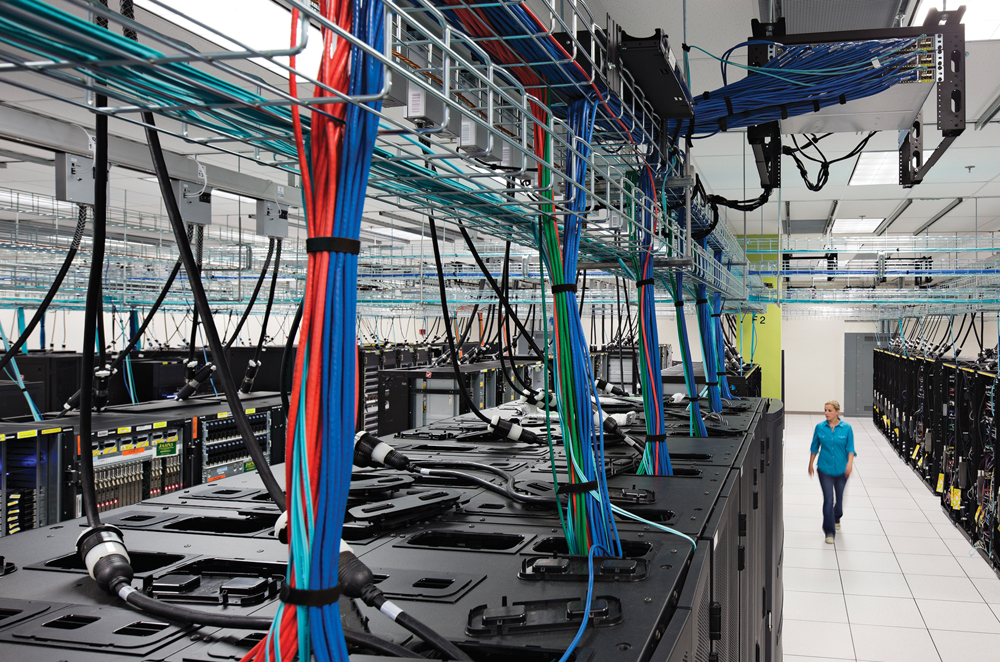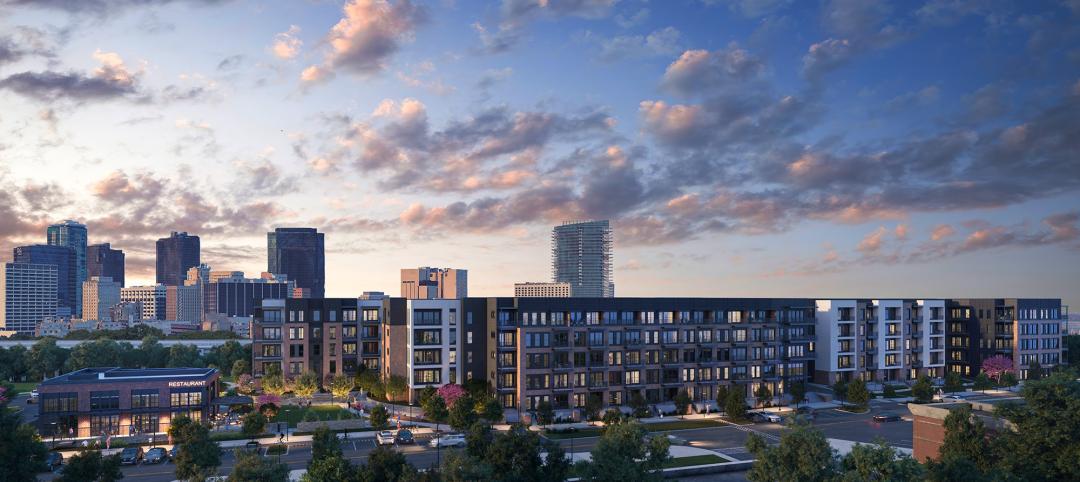While the once white-hot data center construction market has cooled off in recent years, the outlook for this sector remains quite rosy. Each year, businesses and institutions spend billions on data center construction and retrofit projects to keep up with the nation’s insatiable demand for data storage and processing.
The data center sector is conservatively estimated at $13-15 billion annually—larger than the hospitality, amusement/recreation, and water supply sectors, according to U.S. Census Bureau data. And the emergence of cloud computing and storage, combined with the “never delete anything” mindset of consumers and businesses, will only drive demand for data storage and processing.
“The data center market should generally follow the growth of Internet traffic, and Internet traffic continues to grow strongly,” says Craig Deering, AIA, LEED AP, National Practice Leader – Critical Facilities with HDR Architecture.
According to a May 2013 report from Cisco Systems, IP traffic volume in North America is expected to grow to 40 exabytes a month by 2017, a 23% cumulative annual growth rate. Cisco predicts global IP traffic will increase threefold over the next five years. Driving this steep growth are the explosion of networked devices, especially wireless gadgets, and the emergence of video as a dominant content type. Cisco predicts that traffic from wireless and mobile devices will exceed wired devices by 2016, and video will reach 69% of global consumer Internet traffic by 2017.
TOP DATA CENTER ARCHITECTURE FIRMS
2012 Data Center Revenue ($)1 Corgan $27,534,1912 Gensler $23,330,0003 HDR Architecture $16,295,0004 Integrated Design Group $14,598,9105 PageSoutherlandPage $14,450,0006 Reynolds, Smith and Hills $4,360,0007 Callison $3,973,6998 Little $3,655,5909 RTKL Associates $3,634,00010 EwingCole $3,000,000
TOP DATA CENTER ENGINEERING FIRMS
2012 Data Center Revenue ($)1 Fluor $235,678,9002 Syska Hennessy Group $36,735,4343 Jacobs Engineering Group $36,700,0004 H&A Architects & Engineers $35,427,5995 URS Corp. $26,229,0496 Environmental Systems Design $10,575,8927 Parsons Brinckerhoff $10,300,0008 H.F. Lenz $7,357,0009 Science Applications International Corp. $6,760,59810 AKF Group $6,602,000
TOP DATA CENTER CONSTRUCTION FIRMS
2012 Data Center Revenue ($)1 DPR Construction $895,882,4592 Balfour Beatty $753,194,2143 Holder Construction $710,000,0004 Turner Corporation, The $501,750,0005 Whiting-Turner Contracting Co., The $490,093,0456 Mortenson Construction $307,360,0007 Structure Tone $285,725,0008 Skanska USA $236,396,8589 Gilbane $130,362,00010 Carlson Design Construct $128,000,000
Giants 300 coverage of Data Centers brought to you by System Sensor www.systemsensor.com
What does this mean in terms of construction spending growth? If the Data Center Dynamics annual census of the industry is any indication, the data center construction market will remain one of the fastest-growing sectors in the country. According to DCD Intelligence’s most recent survey of nearly 3,800 data center owner/operators and 1,600 vendors, data center facility investment was up 23% on the Coasts and 50% in the central U.S. in 2011-12.
“Calculating the size of the data center market is challenging,” says Deering, “but no matter how you look at it, there’s no doubt that the data center market stands on its own as a distinct and meaningful sector.”
Achieving a lower cost of computing
Shrinking IT budgets and rising operational costs have led data center operators and corporate clients to scrutinize project budgets. As a result, AEC firms are being tasked with finding solutions for lowering the overall cost of computing and operating and maintaining the facilities.
This, in turn, is driving innovation in data center design, including the use of advanced cooling schemes, energy-efficient IT equipment, and higher-density environments. Advanced technologies like KyotoCooling, which utilizes heat wheels to reduce the cooling load on the building’s HVAC system, are becoming more common in U.S. data center projects. In addition, a growing number of data center operators are choosing to build new facilities in northern climates to take advantage of the cooler outdoor air temperatures.
Advancements in server technology, combined with a recent change to ASHRAE’s TC 9.9 Datacom guidelines, means that Building Teams can deliver facilities that operate at higher internal temperatures, greatly reducing cooling costs.
“The top end of the allowable range now is 80.6°F, up from 76°F previously,” says Ronald Vokoun, DBIA, LEED AP BD+C, Mission Critical Market Leader – Western Region with JE Dunn Construction. “Generally speaking, for every 1.8°F that you raise the temperature in your data center, you save 2-4% of your total energy bill. That’s a pretty high and immediate ROI.”
Rising costs are forcing many companies to outsource their data hosting through co-location and cloud services. This trend is leading to the construction of more mega-data center facilities, like CyrusOne’s new Chandler, Ariz., complex, which will eventually house more than
1 million sf of data center space. By 2015, just 2% of the world’s data centers will contain 60% of the floor space, up from 52% in 2010, according to a report from Gartner Inc.
“We will continue to see the concentration of data center floor space into a small community of dominant global players,” says HDR’s Deering.
Retrofits: A growth market
An emerging market for AEC firms is data center retrofits. The first wave of data centers—built during the dot-com boom of the late 1990s—are woefully outdated and are prime for retrofitting. Even the facilities built years later are behind the technology curve, and operators will be looking to upgrade their servers and infrastructure to meet the computing demands of today’s market.
“Many companies are looking at the ‘capex’ versus ‘opex’ dollars and realizing that they can strike a meaningful balance between the two by simply updating, retrofitting, or renovating their existing facilities,” says Jerry Sumrell, PE, Vice President, Mission Critical with RS&H. “This presents new challenges to the design industry, as we will be devoting more time to working in live data center environments with all of the associated risks that come with it. It’s akin to performing open-heart surgery—you have to keep the facility running 24/7 while adding new equipment, decommissioning existing equipment, and transferring power/cooling from one piece of equipment to another.”
Read BD+C's full Giants 300 Report
Related Stories
Mixed-Use | Jan 19, 2024
Trademark secures financing to develop Fort Worth multifamily community
National real estate developer, investor, and operator, Trademark Property Company, has closed on the land and secured the financing for The Vickery, a multifamily-led mixed-use community located on five acres at W. Vickery Boulevard and Hemphill Street overlooking Downtown Fort Worth.
Modular Building | Jan 19, 2024
Building with shipping containers not as eco-friendly as it seems
With millions of shipping containers lying empty at ports around the world, it may seem like repurposing them to construct buildings would be a clear environmental winner. The reality of building with shipping containers is complicated, though, and in many cases isn’t a net-positive for the environment, critics charge, according to a report by NPR's Chloe Veltman.
Sponsored | BD+C University Course | Jan 17, 2024
Waterproofing deep foundations for new construction
This continuing education course, by Walter P Moore's Amos Chan, P.E., BECxP, CxA+BE, covers design considerations for below-grade waterproofing for new construction, the types of below-grade systems available, and specific concerns associated with waterproofing deep foundations.
Sponsored | Performing Arts Centers | Jan 17, 2024
Performance-based facilities for performing arts boost the bottom line
A look at design trends for “budget-wise” performing arts facilities reveals ways in which well-planned and well-built facilities help performers and audiences get the most out of the arts. This continuing education course is worth 1.0 AIA learning unit.
Adaptive Reuse | Jan 12, 2024
Office-to-residential conversions put pressure on curbside management and parking
With many office and commercial buildings being converted to residential use, two important issues—curbside management and parking—are sometimes not given their due attention. Cities need to assess how vehicle storage, bike and bus lanes, and drop-off zones in front of buildings may need to change because of office-to-residential conversions.
MFPRO+ News | Jan 12, 2024
Detroit may tax land more than buildings to spur development of vacant sites
The City of Detroit is considering a revamp of how it taxes property to encourage development of more vacant lots. The land-value tax has rarely been tried in the U.S., but versions of it have been adopted in many other countries.
MFPRO+ News | Jan 12, 2024
As demand rises for EV chargers at multifamily housing properties, options and incentives multiply
As electric vehicle sales continue to increase, more renters are looking for apartments that offer charging options.
Student Housing | Jan 12, 2024
UC Berkeley uses shipping containers to block protestors of student housing project
The University of California at Berkeley took the drastic step of erecting a wall of shipping containers to keep protestors out of a site of a planned student housing complex. The $312 million project would provide badly needed housing at the site of People’s Park.
Apartments | Jan 9, 2024
Apartment developer survey indicates dramatic decrease in starts this year
Over 56 developers, operators, and investors across the country were surveyed in John Burns Research and Consulting's recently-launched Apartment Developer and Investor Survey.
K-12 Schools | Jan 8, 2024
Video: Learn how DLR Group converted two big-box stores into an early education center
Learn how the North Kansas City (Mo.) School District and DLR Group adapted two big-box stores into a 115,000-sf early education center offering services for children with special needs.
















